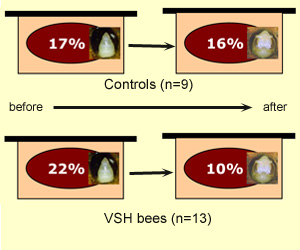For a description of the VSH trait in honey bees, please see Varroa Sensitive Hygiene and Mite Reproduction.
The USDA-ARS Baton Rouge Bee Lab has bred bees that express Varroa Sensitive Hygiene, and we would like to offer a simple technique that queen breeders could use to select for VSH. However, there is no method at this time that is both easy and accurate. We have developed several types of measurement, but the most accurate require significant time at a microscope to evaluate colony performance (Fig. 1).


Select on mite infertility
The most reliable method is to select for a high infertility rate in the mite population (Fig. 2). We are not certain how it happens, but somehow VSH increases mite infertility. Generally, 15-25% of mites in non-resistant colonies do not lay eggs. Infertility increases to 80-100% in colonies with pure VSH queens. Mite populations eventually decline in these colonies because so few mites lay eggs.
In Figure 2, we see the two extremes of mite reproductive success that can be measured using a microscope. The “fertile” mite has produced 4-5 offspring by the time that the host pupa has an evenly tan color on the entire body. The “infertile” mite on the bottom has produced no progeny. There are other possible family structures that one may encounter. For example, there may be a mite that only produces a son and another mite that produces 2-3 offspring but in such a manner that none of the offspring have time to become adult mites before the bee emerges from the brood cell. Fortunately, it is not necessary to record all of these potential family structures. Our research has shown that just focusing on the percentage of infertile mites (breeding for a higher value) will produce bees with high expression of the VSH trait.
Select on high uncapping of infested combs
The second and quickest method is to monitor changes in capped brood after it is exposed to colonies for short periods (3–40 hours). For example, a highly infested comb was cut into halves, and each half was caged with one type of bee for 24 hours (Fig. 3). VSH bees uncapped > 90 pupae, while controls uncapped only 15 pupae. For both types of bees, about 65-80% of all uncapped pupae were mite-infested. Many of the uncapped pupae were chewed, which suggested eminent removal by the bees. A queen breeder could select for those bees that uncap the most mite-infested pupae in a given period of time.

Select using before and after infestation rates

A third method is to compare the infestation of capped brood before and after a comb is exposed to a colony of bees (Fig. 4). We choose combs that contain prepupae as the predominant stage of brood at the start of the test. After the initial infestation rate is measured, the comb is inserted into the
broodnest of a colony for 1 week. The infestation rate is found by examining 200 capped brood cells under a microscope and recording the contents of each infested cell. For example, if 20 mite-infested pupae are detected, the infestation rate would be reported as 10% (20 mite-infested pupae per 200
total pupae that were examined). During the experiment, the bees will gradually mature from prepupae through various pupal stages. The mite families will also grow as each mother mite lays a series of eggs, and each egg hatches to become a nymph that grows through time. We limit the exposure period to 1 week in order to prevent the bees from maturing to the point that they emerge from brood cells before the final infestation rate can be measured.
The infestation of the capped brood is estimated at the beginning and at the end of the test, and the two rates are compared. If no mites are removed from the brood, the two rates will be very similar. Hygienic removal of mite-infested pupae reduces the final infestation rate. Selection would favor colonies with the highest removal of mites in a given period of time.
- Page authors: Jeffrey Harris, Robert Danka and José Villa, USDA-ARS
For a more detailed description of the VSH trait in honey bees, please see Varroa Sensitive Hygiene and Mite Reproduction
For more on selection methods for VSH, see the following publication via the open access link.
- 2009. Simplified methods of evaluating colonies for levels of Varroa Sensitive Hygiene (VSH). Villa, J. D., Danka, R. G., and Harris, J. W. 2009. Journal of apicultural research. v. 48, no. 3, p. 162-167. http://hdl.handle.net/10113/32517
